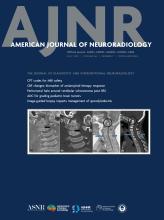Case of the Month
Section Editor: Nicholas Stence, MD
Children's Hospital Colorado, Aurora, CO
October 2016
Next Case of the Month coming November 1 …
Low-Grade Sinonasal Chondrosarcoma
- Diagnosis:
- A 62-year-old woman with progressive right-sided proptosis and nasal obstruction was diagnosed with a low-grade sinonasal chondrosarcoma.
- Gross total resection was performed, followed by adjuvant radiotherapy to treat the intracranial portion of the tumor. There was no evidence of recurrence at 15 months post-op.
- Background:
- Primary sinonasal chondrosarcoma (SNCS) is a locally aggressive, indolent malignancy arising from the cartilaginous nasal septum.
- There is a slight male predominance, with a median age of 40 years at presentation.
- Approximately 10% of all chondrosarcomas occur in the head and neck. The majority of these occur in the larynx, skull base, and mandible, while SNCS comprise a distinct minority.
- Histologic grading is from I (low) to III (high). A low-grade SNCS can present a diagnostic dilemma, with considerable overlap with benign chondroma. Increased cellularity, nuclear atypia, and a high mitotic index distinguish chondrosarcoma from chondroma.
- These tumors have an association with Maffucci syndrome, Ollier’s disease, and Paget’s disease.
- Clinical Presentation:
- Patients often present with a painless mass, visual disturbance, and nasal obstruction.
- Symptoms are related to the extent of local invasion or compression.
- Because of their indolent growth, tumors can be quite large at presentation.
- Key Diagnostic Features:
- CT is useful for evaluating osseous destruction/expansion, while MR is better for resolving local soft tissue invasion, including orbital involvement and intracranial extension. MR can also better define tumor margin relative to trapped secretions.
- CT: lobular mass with internal stippled appearance of rings and arcs of calcification typical of chondroid matrix; osseous erosions; expansion of the nasal septum. Tumoral calcification is scattered throughout the mass in contrast to bone fragments, which are adjacent to normal osseous structures. Both may be present.
- MR: T1 hypointense; strongly T2 hyperintense (chondroid matrix with high water content); heterogeneous curvilinear septal enhancement with gadolinium = intervening fibrovascular bundles between cartilaginous lobules
- PET: Low-grade chondrosarcoma is not hypermetabolic, and PET is unreliable in differentiating chondroma from low-grade chondrosarcoma. High-grade chondrosarcoma may demonstrate more avid FDG uptake.
- Differential Diagnosis:
- chondroma, inverted papilloma, osteosarcoma, SNUC, esthesioneuroblastoma, ossifying fibroma, meningioma, fibrous dysplasia
- Treatment:
- Surgical resection is the standard of care.
- Radiation is indicated in cases of high-grade histology, positive surgical margins, or unresectable tumors, although chondrosarcomas are generally thought to have low radiosensitivity due to their slow proliferation.
- Long-term follow-up is recommended, as recurrences can develop after decades of stability.
- The overall 5-year disease-free survival rate after resection is 54-77%, with the most common cause of death being local skull base invasion. Distant metastases occur in 7%, typically to the lung.











